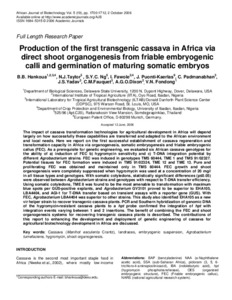| dc.contributor.author | Hankoua, B. |
| dc.contributor.author | Taylor, N. |
| dc.contributor.author | Ng, S. |
| dc.contributor.author | Fawole, I. |
| dc.contributor.author | Puonti-Kaerlas, J. |
| dc.contributor.author | Padmanabhan, C. |
| dc.contributor.author | Yadav, J.S. |
| dc.contributor.author | Fauquet, Claude M. |
| dc.contributor.author | Dixon, A. |
| dc.contributor.author | Fondong, V.N. |
| dc.date.accessioned | 2019-12-04T11:18:06Z |
| dc.date.available | 2019-12-04T11:18:06Z |
| dc.date.issued | 2006 |
| dc.identifier.citation | Hankoua, B., Taylor, N., Ng, S., Fawole, I., Puonti-Kaerlas, J., Padmanabhan, C., ... & Fondong, V.N. (2006). Production of the first transgenic cassava in Africa via direct shoot organogenesis from friable embryogenic calli and germination of maturing somatic embryos. African Journal of Biotechnology, 5(19), 1700-1712. |
| dc.identifier.issn | 1684-5315 |
| dc.identifier.uri | https://hdl.handle.net/20.500.12478/3045 |
| dc.description.abstract | The impact of cassava transformation technologies for agricultural development in Africa will depend largely on how successfully these capabilities are transferred and adapted to the African environment and local needs. Here we report on the first successful establishment of cassava regeneration and transformation capacity in Africa via organogenesis, somatic embryogenesis and friable embryogenic callus (FEC). As a prerequisite for genetic engineering, we evaluated six African cassava genotypes for the ability of a) induction of FEC b) hygromycin sensitivity and c) T-DNA integration potential by different Agrobacterium strains. FEC was induced in genotypes TMS 60444, TME 1 and TMS 91/02327. Potential tissues for FEC formation were induced in TMS 91/02324, TME 12 and TME 13. Pure and proliferating FEC was obtained and maintained only in TMS 60444. FEC growth and shoot organogenesis were completely suppressed when hygromycin was used at a concentration of 20 mg/l in all tissue types and genotypes. With somatic cotyledons, statistically significant differences (p 0.05) were observed between Agrobacterium strains and genotypes with respect to T-DNA transfer efficiency. Using somatic cotyledons, TME 8 was found to be the most amenable to transformation with maximum blue spots per GUS-positive explants, and Agrobacterium GV3101 proved to be superior to EHA105, LBA4404, and AGl-1 for T-DNA transfer based on transient assays with a reporter gene (GUS). With FEC, Agrobacterium LBA4404 was superior to other strains. This study also identified EHA105 as a new virus helper strain to recover transgenic cassava plants. PCR and Southern hybridization of genomic DNA of the hygromycin-resistant cassava plants to a hpt probe confirmed the integration of hpt with integration events varying between 1 and 2 insertions. The benefit of combining the FEC and shoot organogenesis systems for recovering transgenic cassava plants is described. The contributions of this report to enhancing the development and deployment of genetic engineering of cassava for agricultural biotechnology development in Africa are discussed. |
| dc.description.sponsorship | Swiss Agency for Development and Cooperation |
| dc.language.iso | en |
| dc.subject | Cassava |
| dc.subject | Landraces |
| dc.subject | Embryogenic Suspension |
| dc.subject | Agrobacterium Tumefaciens |
| dc.subject | Hygromycin |
| dc.subject | Shoot Organogenesis |
| dc.title | Production of the first transgenic cassava in Africa via direct shoot organogenesis from friable embryogenic calli and germination of maturing somatic embryos |
| dc.type | Journal Article |
| dc.description.version | Peer Review |
| cg.contributor.affiliation | Delaware State University |
| cg.contributor.affiliation | International Institute of Tropical Agriculture |
| cg.contributor.affiliation | Donald Danforth Plant Science Center |
| cg.contributor.affiliation | University of Ibadan |
| cg.contributor.affiliation | European Patent Office, Germany |
| cg.coverage.region | Acp |
| cg.coverage.region | Africa |
| cg.coverage.region | Asia |
| cg.coverage.region | North Africa |
| cg.coverage.region | West Africa |
| cg.coverage.region | Southeast Asia |
| cg.coverage.region | Europe |
| cg.coverage.country | United States |
| cg.coverage.country | Nigeria |
| cg.coverage.country | Thailand |
| cg.coverage.country | Germany |
| cg.isijournal | ISI Journal |
| cg.authorship.types | CGIAR and developing country institute |
| cg.iitasubject | Genetic Improvement |
| cg.iitasubject | Plant Genetic Resources |
| cg.iitasubject | Plant Diseases |
| cg.iitasubject | Research Method |
| cg.iitasubject | Disease Control |
| cg.iitasubject | Farm Management |
| cg.iitasubject | Pests Of Plants |
| cg.iitasubject | Plant Breeding |
| cg.iitasubject | Livelihoods |
| cg.iitasubject | Cassava |
| cg.iitasubject | Post-Harvesting Technology |
| cg.iitasubject | Farming Systems |
| cg.iitasubject | Plant Health |
| cg.iitasubject | Plant Production |
| cg.iitasubject | Handling, Transport, Storage And Protection Of Agricultural Products |
| cg.accessibilitystatus | Open Access |
| local.dspaceid | 94511 |

